Create
Vintage St. Pete: The Big 13 family album
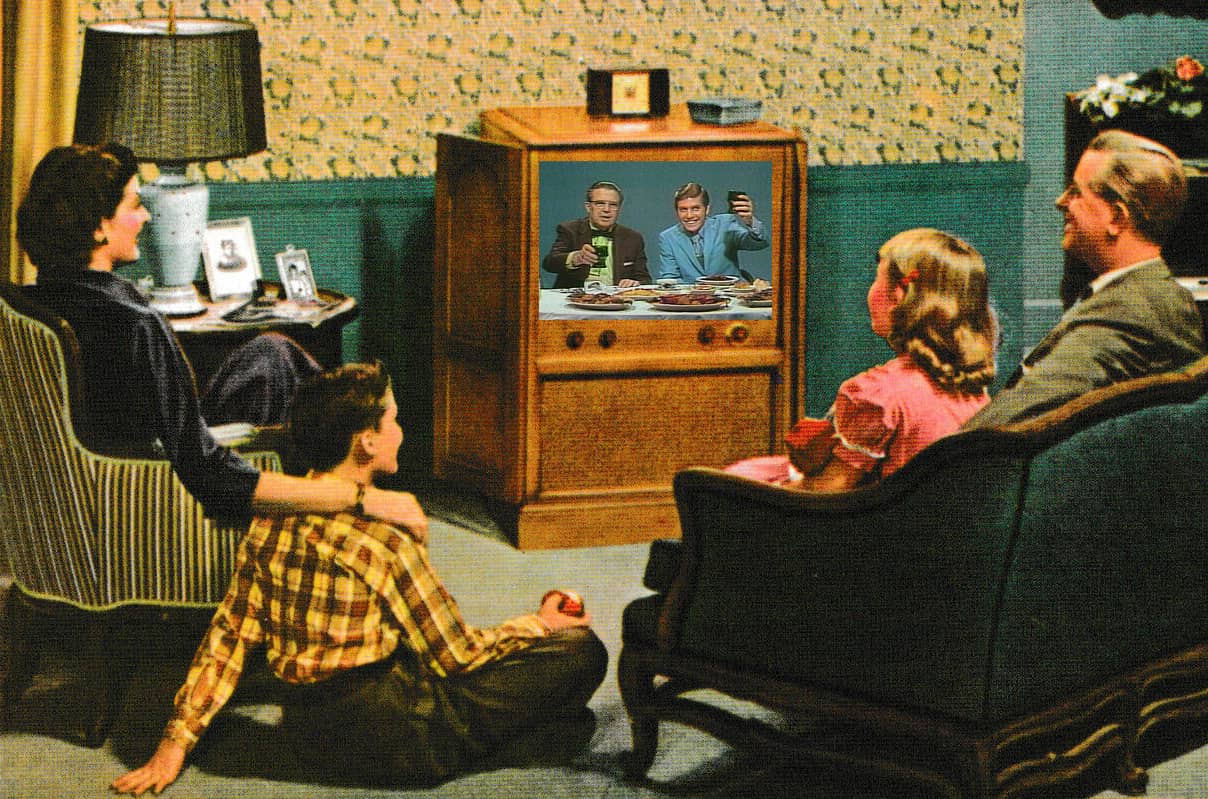
Just give me Dixie, where folks are smilin’
And all the while invitin’ you there.
Where friends will greet you, say ‘I’m glad to meet you’
Sunshine is everywhere.
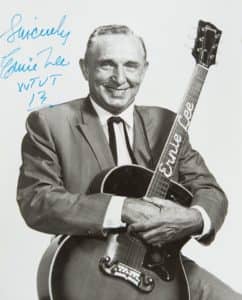
Ernie Lee
Every weekday at 7 a.m., bay area residents turned on their TVs to this welcoming song from friendly-faced singer and guitar player Ernie Lee. The show, on WTVT-Channel 13, was Good Day, and it was the station’s bacon-and-eggs sunrise programming from 1956 until the early 1990s (by then, it had been re-titled Breakfast Beat).
Ernie Lee’s country music, interview segments and corny hillbilly jokes were interspersed with news, sports and weather. In the 1960s and ‘70s, before CBS had its own morning show, Good Day/Breakfast Beat regularly out-performed rival NBC’s Today Show (broadcast locally on the competition, WFLA-Channel 8). Ernie Lee was one of Tampa Bay’s first big stars.
The network took an hour for Captain Kangaroo, but otherwise the morning belonged to Ernie and his friends.
Until the arrival of cable television in the 1980s, there were, in essence, just three channels in the bay area, one for each national network. The on-air personalities at WTVT – or Big 13, as it nicknamed itself – were some of the most recognizable residents of St. Petersburg and Tampa.
Big 13 was Number One in the ratings for 25 years, between 1962 and 1987.
The Fox network took over management of WTVT in 1994, and the morning show, in a different form, still exists (as Good Day Tampa Bay). For the generations who came of age watching Big 13, however, “local TV” means Ernie, Salty Sol, Roy, Mary Ellen, Paul, Shock, Andy, Hugh and handful of other indelible personalities.

Ray Blush
Ray Blush, who’d been a reporter, news director and the creator and host of the groundbreaking Project 13 documentary series (as well as the host of the high school game show High-Q) is virtually the last man standing from those early, all-important days.
It was, Blush said, “The best of times. Because today the whole journalism industry has changed. It was just a lot different back then – socially, morally, economically, you name it.”
It was easy to identify with the men and women you saw regularly on TV. Tampa Bay was a much smaller community, and when these people came into your home, day after day, you were generally happy to see them.
They were happy to be there together. “We were not only working professionals, side by side, we really were a family,” reflected Blush. “We had a family atmosphere there. We were friends and we did a lot to help each other along the way. And we did a lot out in the community. It was a wonderful experience.”
Salty Sol Fleischman

Salty Sol Fleischman
Sol Fleischman was a known commodity when he was hired by WTVT in 1957, replacing original sports director Guy Bagli. He’d been a popular sportscaster for WDAE radio, and wrote a fishing column in the Tampa Times (which is where he acquired the nickname “Salty Sol”).
Gregarious and fun-loving, Fleischman’s folksy personality came through on his daily forecasts – he appeared on Good Day/Breakfast Beat, the noontime Pulse Plus and the 6 p.m. evening broadcast.
He was an avid boater who lived to fish, and his evening segments featured “Salty’s Best Bets,” educated predictions and suggestions for the next morning’s fishing.
“He was anything but the slick, slim, good-looking master of ceremonies sort of anchor,” explained his son, Tampa architect Sol Fleischman Jr. “He was always fat, he was baldheaded, but he just had a way. He was charismatic and he loved to talk to people. He loved people.”
And people loved him. Fleischman pioneered a bit called “Where Am I?,” in which he’d show a snippet of silent film of someplace or other in Tampa Bay. The viewer who guessed correctly won a prize (reportedly, one week 5,000 cards and letters arrived at the station).
Salty Sol, who’d grown up in Plant City, had always been passionate about sports. “Back in his early days, he was quite an accomplished high-board diver and swimmer in high school,” said Sol Jr. “Legend says he swan around Davis Island with some famous swimmer, while he covered it for the radio.”
At home, Dad was “just like he was on TV. Bigger than life.”
 And he was especially popular with children, who always recognized his big smile and signature yachting cap. “Little kids would come up to our table at a restaurant and point: ‘Salty Sol!’ Salty Sol! Can I have your autograph?’ And he would always accommodate them, and be nice to them, no matter that they interrupted our dinner. That’s the way he was.”
And he was especially popular with children, who always recognized his big smile and signature yachting cap. “Little kids would come up to our table at a restaurant and point: ‘Salty Sol!’ Salty Sol! Can I have your autograph?’ And he would always accommodate them, and be nice to them, no matter that they interrupted our dinner. That’s the way he was.”
Veteran bay area sportscaster Dick Crippen, who worked at the competition – both WFLA and at WLCY-Channel 10 (the ABC affiliate) – concurred.
On the air, Crippen reflected, “He was literally talking to everybody. I think he set a very high standard as far as that presentation went. I think people felt at home with him.
“I knew Sol on and off the screen, and he was a great guy. He often told me he wished he’d hired me, and I took that as a very high compliment. But I knew very well that he’d hired Andy, and he did just fine with Andy.”
Andy Hardy, who was Fleischman’s assistant in the early days, became WTVT’s sports director when the veteran retired in 1974. Although he then had more time to be aboard his beloved boat, Salty Sol couldn’t stay away from the station. He continued to do “Where Am I?’ until 1984, when he hung up his cap for good.
Andy Hardy

Andy Hardy
“Andy may have been 18 or 20 when he started with Dad, and he looked like he was 15 or 16,” recalled Sol Fleischman Jr. “Andy was wonderful. He allowed Dad not to work so hard. Andy would go out and bird-dog stories and interview sports celebrities. He was a terrific assistant to my dad, and then went to take over after he left.”
Quick-witted Pennsylvanian Andy Hardy always contended he’d been named for the character in those old Mickey Rooney movies. Prior to joining WTVT in 1962, he’d played on a championship Army baseball team. He and Salty Sol, 20 years Hardy’s senior, were a perfect match – “almost like father-and-son,” said Sol Jr.
“Andy,” remembered Mike Clark, who worked in the station’s production department and now operates Big13.com, a website devoted to WTVT history, “was brilliant and very, very funny. Like Sol, he was always joking and laughing with the crew. And he had an encyclopedic mind for sports. When you’re reading off these stats, and you’re looking at copy and watching the monitor, you have to have an overall knowledge of what’s going on and be able to articulate it.”
“When we were off the air, we were competitive but friends,” offered Dick Crippen, who like Hardy exuded a boyish excitement on the air. “But on the air, we were out to get the ratings. It was a good game.”
Still, Crippen remembered, when the competitors were at a high school football game, for example, and one ran out of film for his camera (in the days before video was ubiquitous), the other would gladly pull an extra reel out of his bag and hand it over. They did it out of respect.
 Crippen also thinks he and Hardy were pioneers in local TV – they did more than just “rip and read” stats and wire copy. They actually went to the events themselves and talked to folks. “We both had big followings on Friday night,” he said.
Crippen also thinks he and Hardy were pioneers in local TV – they did more than just “rip and read” stats and wire copy. They actually went to the events themselves and talked to folks. “We both had big followings on Friday night,” he said.
“It was a battle, but I think we brought in a more modern take on the sports. Not to say Sol and the other sports guys weren’t getting out! But when Andy and I got in there, both of us were fighting a little bit harder for ratings. So we were getting out a lot, and I think that made the difference.”
Hardy was also adept at live in-studio bantering with the cartoonish wrestlers from Gordon Solie’s World Champion Wrestling From Florida, for which WTVT provided production.
“Andy had offers from other stations, but I think the Tampa Bay area was very interesting to him, because all the baseball teams did their spring training there,” Clark explained. “And there were plenty of opportunities to interview the top people in sports.”
He was WTVT’s sports director for 22 years, resigning for health reasons in 1996, not long after Fox took the station over.
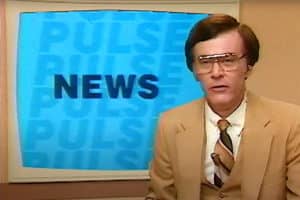
Among his many firsts, longtime Big 13 anchor (and 15-year news director, succeeding Ray Dantzler) Hugh Smith was the station’s first on-air talent to be broadcast in color, in 1966 (this is a screengrab from much later). He also pioneered the live remote, using then-new ENG (Electronic News Gathering) technology including video cameras (film was finally phased out in the late 1970s). In 1976, Smith anchored the evening news from a helicopter hovering over downtown Tampa.
Hugh Smith
Longtime news director and anchor of Pulse, the evening newscast, Hugh Smith’s no-nonsense style and stentorian delivery projected an air of authority and confidence. The midwesterner joined WTVT as a reporter in 1963, and was promoted to news director in 1968, a position he held for 15 years. As such, he managed a staff of 30 people – all while anchoring the news, at noon and again in the evenings, five days a week. And doing his own reporting.
He was, say all who knew him, the consummate news professional.
Weary of the grind, Smith voluntarily stepped down as news director. “I worked for Hugh, and then Hugh worked for me,” laughed Ray Blush, who took over the managerial position. “Hugh was one of the best employees I had – he knew what I had to go through as news director, because he had been on that train.”
Smith remained in the Top Dog spot, news anchor, until 1991, all the while continuing to report – and write, and film, and edit – stories on his own.
 Among the many things he brought to Channel 13, Smith doggedly covered the unsteady politics of the Hillsborough County School Board.
Among the many things he brought to Channel 13, Smith doggedly covered the unsteady politics of the Hillsborough County School Board.
“I thought everybody came out of the TV,” said Smith’s son Ward. “They all lived in there with Dad – Ernie Lee, John Wayne, Flip Wilson’s gotta be in there. But when I went to the station, they weren’t there. And the control room was like NASA.”
Sometimes, Dad would bring them into the Tampa studios on Saturdays, if he had something to attend to. “Everything was shot on film in those days, and I’d go into the edit rooms,” Smith recalled. “All the cut film would be in tubs on the floor.
“Andy Hardy showed me how to put the films into the Moviola, watching all this University of Tampa sports footage – ‘if you run it backwards, you can watch the guy running backwards.’ I’d stand there for hours just watching a guy throw a football, and catching it backwards.
“I found somebody’s stuff that was already on the Moviola, in the editor. And I cut it up and turned it upside down.”
Oops. “It must have been somebody’s story, ready to go.”
And that was it for young Ward’s visits to WTVT central command. Today, he is an actor and comedian, and the co-owner (with his sister Karen) of the Off-Central, a playhouse on 1st Avenue South in St. Petersburg.
Smith does, however, have warm and fuzzy memories of the annual Big 13 Christmas parties, and of accompanying the old man to Media Day at places like Busch Gardens and Walt Disney World, where he was allowed to ride the rides – for free – as much as he wanted.
And he remembers being proud of his father, who was a WTVT fixture – for some, the very voice and face of Big 13 – for 27 years.
“When we would go out, people would come up and say ‘Hey Hugh, we saw that story you did on City Hall. You keep those officials honest.’ Everybody would say nice things. ‘We watch you every night. Keep up the good work.’ That was kind of a neat thing.”
Mary Ellen

Mary Ellen (and Poopdeck)
Mary Ellen Colchagoff and her husband left Ohio, and its bitter winters, for St. Petersburg in 1957. She brought along a kinescope of Fun Farm, the children’s show she’d hosted back home in Toledo, and when the general manager of WTVT saw it, he hired her on the spot to host Popeye Playhouse and, later, Giant Kids Matinee. With a live parrot called Poopdeck perched on her shoulder, Mary Ellen (her surname, not exactly TV-friendly, was dropped) she introduced cartoons, drew pictures and talked merrily to the 12 to 15 kids comprising her “studio audience.”
This was created as direct competition for Captain Mac’s Adventure Trails, aired live via weak UHF signal from the Million Dollar Pier by WSUN-Channel 38. Like Burl McCarty, who played Captain Mac, Mary Ellen became a local celebrity and made frequent personal appearances in Tampa and St. Petersburg.
 By 1962, her popular half-hour had been re-titled The Mary Ellen Show. It aired weekday afternoons, sandwiched between a half-hour of shorts and cartoons hosted by space adventurer “3-D Danny” (WTVT staff announcer Ed Scott) and his robot “Ruffnik,” and Pulse, the evening news program.
By 1962, her popular half-hour had been re-titled The Mary Ellen Show. It aired weekday afternoons, sandwiched between a half-hour of shorts and cartoons hosted by space adventurer “3-D Danny” (WTVT staff announcer Ed Scott) and his robot “Ruffnik,” and Pulse, the evening news program.
Both 3-D Danny and The Mary Ellen Show were televised live, back-to-back, from, the same studio.
On his website, Mike Clark wrote: “At one point in the program, Mary Ellen would have the kids look directly into the camera for the ‘Magic Eye.’ The Magic Eye was actually a special effect created by the switcher in the control room. As the camera panned from one child to the next, the director would use a circle wipe and surround the child’s image with the CBS eye.
“When the camera stopped on the ‘chosen’ child, the circle would vibrate, signifying that this lucky youngster was ‘King’ or ‘Queen’ for the day. The child was then adorned with a royal scepter and crown and given a prize, usually a food product from whatever sponsor was on the show that week. How often I envied the lucky youngster who walked away with an arm-sized Tootsie Roll containing several days’ worth of treats!”
The Mary Ellen Show was canceled in 1964.
Paul Reynolds
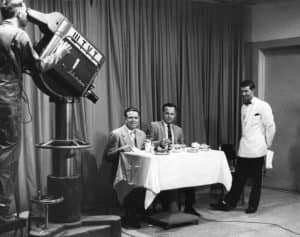
“Salud and Happy Days”: Valencia Gardens’ Manuel Beiro, left, with Paul Reynolds, late 1950s.
One of Andy Hardy’s most memorable roles on Big 13 was as the “dinner companion” of Manuel Beiro, the real-life owner of Valencia Garden, a Spanish restaurant just down Tampa’s Grand Central (later Kennedy) Boulevard from WTVT headquarters.
Every Friday night, just after the 11 p.m. news, Hardy and Beiro – live in the studio – would offer a Sangria toast (“Salud and happy days”) and proceed to talk about whatever freshly-prepared specialties the restauranteur had brought with him that night. It was a paid commercial spot.
(Each toast ended with a number, i.e. “Salud and happy days No. 1,165,” and a persistent bay area rumor was that Beiro was calling out the winning numbers in a popular-but-illicit Cuban lottery game called bolita. In truth, he was announcing, out of sequence, how many commercials he’d done at WTVT since the late 1950s. It was an inside joke.)
When they were done, Hardy would introduce Shock Theatre – the weekly late-night scary movie. And the grateful studio crew would chow down on fresh Spanish food.
It’s impossible, though, to talk about Valencia Garden – or Shock Theatre – without mentioning Paul Reynolds.
A disc jockey for St. Pete’s WTSP radio, Reynolds was hired as WTVT’s first “booth announcer,” meaning it was his mellifluous voice doing all the announcements, all the commercials … he even signed the station on the air on Day One, April 1, 1955.
He was a sports reporter and announcer. He hosted a teenage dance party show, and a late-night interview program … which is where he first encountered new sponsor Manuel Beiro and Valencia Garden.
Reynolds was the “Salud and happy days” guy until 1968, when he left the station, for greener pastures, after a dozen years.

Reynolds as Bozo.
He’d briefly “played” Bozo the Clown on the WTVT’s earliest children’s segments, and in 1965 the station manager told him he’d be debuting as Shock Armstrong, the “host” of Shock Theatre, on Friday nights.
“There wasn’t anything that Paul Reynolds couldn’t do,” explained Clark. “You just plug him in and he goes. And when they told him he was going to be Shock Armstrong, he didn’t even blink. A week later, they had the mask, they had the shirt, and he’s on the air.”
The mask was a cheap, all-purpose Frankenstein number with a zipper up the back – it was too big but Reynolds wore it anyway – and his costume was a University of Tampa football jersey (Number 13, of course) with shoulder pads.
Shock was, the station declared, a “teenage ghoul,” and he presided over a set made up to look like the bedroom of a messy adolescent.
The films, which stations in those days bought as a syndicated package (this one was literally called Shock) included old Universal monster titles and science fiction B-movies from the ‘50s.

Shock Armstrong
Shock Armstrong slept in a coffin, was devoted to his fuzzy wolfman doll Lamby-Pie, and was tormented by the off-camera screams from his (never-seen) mother. In the first episodes, he merely grunted. But Reynolds, an adept ad-libber, developed a (grouchy) personality for his character. And when Shock began to talk, and complain, and make crummy jokes, he developed a solid following of young fans.
No footage exists from those early, videotaped days (there’s no Good Day, either, or Mary Ellen, and only a few minutes of a black-and-white episode of Pulse). Tape was expensive, so each week’s show was recorded over when it was time to do the next one.
But Shock Armstrong, at least in memory, remains.
“There was something about the character that resonated with viewers,” Clark said. “He became popular, so much so that when you said ‘Channel 13,’ that was sometimes the first name they came up with. If they grew up in a certain era.”

Shock Theatre continued, without a live host, until 1974 when the CBS network launched its first (failed) attempt at programming against Johnny Carson and the Tonight Show.
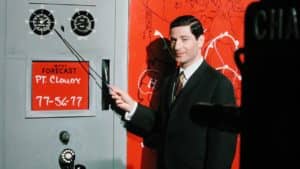
Roy Leep, 1959
Roy Leep
For 40 years, Roy Leep was WTVT’s chief meteorologist. That’s not a world record, but it’s darn close, and generations of area TV-watchers, from the Big 13 era to the more contemporary days of Fox 13, learned to rely on the soft-spoken Kentuckian for the latest updates and the most accurate forecasts.
“The weather in Central Florida is very interesting for a weatherman,” Mike Clark observed. “And he really upped the game for weather reporting on local television.” Because of Roy, WTVT became the first television station in Florida to buy and install its own radar station. He helped design new forecasting technology. He flew in hurricane spotter planes. He was obsessive, and he was thorough.
Paul Dellegatto has been with the WTVT weather department since 1990, before it transitioned into Fox 13. When Leep retired in 1997, he became Chief Meteorologist, a position he’s held since. Dellegatto knew he had some big shoes to fill, as Roy Leep, with his measured, studious-but-friendly delivery, was virtually synonymous with Tampa Bay TV.
 Reporting anything on television – news, sports or weather – takes a skillful combination of journalistic skills and likeability, along with a smattering of showbiz. “You want the viewer to feel like you’re right there in their living room,” said Dellegatto. “And Roy had such a great way of talking. I always admired his communication style, which was kind of folksy, yet very smooth. He was a good explainer. The business is all about communication.”
Reporting anything on television – news, sports or weather – takes a skillful combination of journalistic skills and likeability, along with a smattering of showbiz. “You want the viewer to feel like you’re right there in their living room,” said Dellegatto. “And Roy had such a great way of talking. I always admired his communication style, which was kind of folksy, yet very smooth. He was a good explainer. The business is all about communication.”
Scud the Weather Dog, Leep’s own cairn terrier, added the showbiz factor on 1990s broadcasts.
That fact that Leep established himself in the days before apps, computers and cell phones was crucial to his success, according to Dellegatto. “In that era, there was really no place else to go to get weather, except on TV,” he said. “People went to a person that they would trust, and have confidence in – and in this market, he was that man.
“And in those 40 years he was able to introduce a lot of technology that people just weren’t used to seeing, whether it was radar, satellites … along with a delivery style that was comforting and reassuring and confident, he had a lot of good equipment. And the station had a great reputation. It was a powerhouse station. So a lot of things came together to make him the legend that he was.”
Fascinated by the weather since his teenage years, Leep maintained a weather station at his home until his death in 2021. He had been a member of the American Meteorological Society for over 60 years, and was elected a Fellow.
Here’s a link to a 1975 Big 13 documentary featuring Roy conducting a tour of the studio weather facility.
It was, Dellegatto believes, Lee’s scientific understanding of hurricanes and the other severe weather that plagues Florida that endeared him to viewers.
“That’s really what happens in this business – over time, you go through a number of major storms, and people will be watching. If you give people the proper information, if you deliver it in a way that’s not alarming, you will build a big following over time.
“Because people will come to trust you. And I think that was a big reason for his success.”
Ernie Lee
When Ernie Lee came to Tampa/St. Pete in 1954, he was already a regional star in the Midwest, making regular appearances on radio (in his native Kentucky) and on fledgling television stations in Cincinnati and Detroit. A singer, guitar player and bandleader born Ernest Eli Cornelison, he’d released a handful of catchy country music singles (both 78s and 45s) on various labels including MGM and RCA. They were regional, not national hits; Lee was a personable, likeable southerner with a smooth baritone voice and a keen sense of humor.
He was invited down by an old friend then working at WSUN, the area’s first TV station, and he worked there for four years (Ernie Lee and the Florida Ranch Boys, The Beach Club with Reba Fox and Ernie Lee and Riddle-dee-dee with Ernie Lee).

Good Day premiered on WTVT April 15, 1958, showcasing Lee with a country band that included the singing husband-and-wife team Herb and Kay Adams, old friends from Ohio, and other musicians he knew from his midwestern days.
Both Herb and Kay take solo turns on the locally-produced album Ernie Lee’s Big 13 – Songs From the ‘Good Day’ Show, issued in 1956.
Click on the link below to hear Ernie singing “Pick Me Up and Set Me Down in Dixie” from the album:
Mike Clark, who worked on the studio crew for most of the 1970s, said Ernie Lee was a presence you could not miss. “I’m not a country music fan myself, but Ernie was so charming and so great I kind of got lured into it,” Clark explains. “He turned me around.
“All these on-air people had a really good relationship with the people around them on the crew. With Ernie Lee, if you were just starting or if you had been there a few years, he treated you equally.”
Lee stayed with the station until 1991, when declining health forced him to retire. He died less than a year later, after 34 years at WTVT.
Lee’s signoff, every morning, was delivered directly into the camera:
“Put on the coffee pot, Jeanie. I’m comin’ home.”
Give me Dixie when night is fallin’
And birds are callin’ by moonlit streams
Let me lie there
Live and die there
Give me Dixie, land of my dreams.
Thanks to Mike Clark/big13.com for the images. This story appears in the book Vintage St. Pete and Vintage Pinellas Volume 3 (St. Petersburg Press).








Jim Budka
January 23, 2023at1:49 pm
Bob Livingstone, aka Bob Stone worked with Andy Hardy in the sports department. Behind the scenes and on camera. He also was my assistant audio man on the CBS Tampa Bay Buccaneers football broadcasts. Wonderful kind hearted person. Will always miss working with him.
john trull
March 13, 2022at1:30 pm
My father was Chris Trull he worked for WSUN in the 50’s and 60’d he hosted shows like “Meet your Neighbor” played Sad Sam (Emmit Kelley) played cartoons/ read Funnies, Traderhorn, 6pm news anchor, Christmas show every year on the Million Dollar Pier,as kids we practically grew up on the pier while Dad was working
Tom Peter
March 12, 2022at3:42 pm
My step dad, Jim Edison (Dynamite Jim), a country musician, was a frequent guest on the Ernie Lee show. He played a mean guitar and often appeared along with Brownie Reynolds (Barefoot Brownie) and Dewey Tew who played steel guitar. As a teenager back then, I got to meet many of the local TV personalities and accompanied my dad many times to the TV station in the very early hours of the day. I really wish I could get copies of some of the broadcasts with Ernie, my dad, Dewey and Brownie, but the only thing I have found is a low quality YouTube clip. Those were good times.
Product Review
March 12, 2022at8:34 am
Style, typography, shot, icons – classic!!
https://productreview2022.tumblr.com/